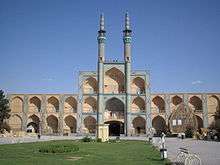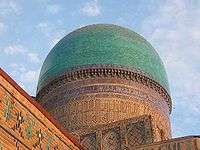Azeri style
The "Azerbaijani style" or "Azeri style" (Persian: شیوهٔ معماری آذری) is a style (sabk) of architecture when categorizing Iranian architecture development in Iranian Azerbaijan history. Landmarks of this style of architecture span from the late 13th century (Ilkhanate) to the appearance of the Safavid Dynasty in the 16th century CE.[1]
Examples of this style are Dome of Soltaniyeh, Arg e Tabriz, Jameh Mosque of Varamin, Goharshad Mosque, Bibi Khanum mosque in Samarqand, tomb of Abdas-Samad, Gur-e Amir, Jameh mosque of Yazd and Jameh Mosque of Urmia.[2]
Gallery
See also
References
- ↑ Fallāḥʹfar, Saʻīd (سعید فلاحفر). The Dictionary of Iranian Traditional Architectural Terms (Farhang-i vāzhahʹhā-yi miʻmārī-i sunnatī-i Īrān فرهنگ واژههای معماری سنتی ایران). Kamyab Publications (انتشارات کامیاب). Kāvoshʹpardāz. 2000, 2010. Tehran. ISBN 978-964-2665-60-0 US Library of Congress LCCN Permalink: http://lccn.loc.gov/2010342544 pp.16
- ↑ Sabk Shenasi Mi'mari Irani (Study of styles in Iranian architecture), M. Karim Pirnia. 2005. ISBN 964-96113-2-0 pp.204-205
External links
- Multiple Authors. "ARCHITECTURE". Encyclopaedia Iranica Online Edition. Retrieved 15 April 2012.
- Kröger, Jens. "STUCCO DECORATION IN IRANIAN ARCHITECTURE". Encyclopaedia Iranica, Online Edition,. Retrieved 15 April 2012.
This article is issued from
Wikipedia.
The text is licensed under Creative Commons - Attribution - Sharealike.
Additional terms may apply for the media files.





-Jerusalem-Temple_Mount-Dome_of_the_Rock_(SE_exposure).jpg)